From an Article by Harry Stevens, Axios, June 23, 2018
Three decades have passed since then-NASA scientist James Hansen testified before the Senate Energy committee and alerted the country to the arrival of global warming.
Why it matters: The predictions of the world’s leading climate scientists have come true, with dire consequence for the planet.
In the 30-year period prior to Hansen’s testimony, the Earth’s surface was, on average, less than 0.2°F warmer than the 20th-century average. In the 30 years since, the planet’s surface has, on average, undergone a six-fold temperature increase.
Hansen’s temperature projections weren’t exactly on target, since he projected a slightly higher amount of warming than what has occurred, but about two-dozen climate scientists told Axios that overall, his main conclusions were right.
Sign up for Axios newsletters to get our smart brevity delivered to your inbox every morning.
In his June 23, 1988 testimony, Hansen made three key points:
The Earth has gotten warmer. So warm, in fact, that the temperature trend was almost certainly due to the greenhouse effect, which is enhanced by emissions of gases like carbon dioxide and methane from burning fossil fuels.
As a result, summer heat waves and other extreme weather events will become more common.
“The greenhouse effect has been detected, and it is changing our climate now,” Hansen said. When he spoke, 1988 was on track to become the hottest year of all-time. Since then, that record has been broken six more times – in 1990, 1998, 2010, 2014, 2015 and 2016.
In an interview with the Guardian this week, Hansen gave a bleak assessment of the last thirty years. “All we’ve done is agree there’s a problem,” he said. “We haven’t acknowledged what is required to solve it.”
Be smart: Uncertainty is often cited as a reason for not addressing climate change, but the longer we go without addressing it, the harder it will be to cut emissions and avert major impacts.
As Andrea Dutton, a climate scientist at the University of Florida, told Axios:
“The true debate lies in the solutions and in mobilizing the social and political will to act upon our knowledge. Deciding not to act is a choice itself, and one that we cannot correct later. The time to act is always now. Because the longer we wait, the worse the outcomes will be.”
About the graphic: The spinning globes compare the average temperature of the Earth’s surface during the 30-year periods before and after Hansen’s testimony, relative to the average surface temperature from 1901–2000.
The data used to create the graphic was downloaded from NASA’s Goddard Institute for Space Studies. The land surface temperature data is from a GISS analysis, while the ocean temperature data comes from NOAA. The smoothing radius was set to 1,200 kilometers.
Take a Deep Dive on the issue of climate change:
>> Where climate change will hit the U.S. hardest.
>> Cheat sheet: How climate change affects our weather.
>> Climate change is here to stay, so deal with it.
>> Are big corporations fighting global warming?
>> Five (5) transformative energy technologies to watch.
>> An energy and climate glossary for Trump (and everyone).
>> The political divide over climate science.
>> A Trump-supporting Texas city runs on 100% renewable energy.
#####################
The Arctic is unraveling as climate change intensifies
From an Article by Andrew Freedman, Axios, December 13, 2018
Rapid climate change is transforming the Arctic, from the bottom of the sea floor to the top of windswept glaciers. Sea ice is disappearing, land-based ice is melting and a domino effect of ecosystem changes have been set into motion, with unknown results.
Why it matters: New research published this week shows the peril that awaits companies that choose to operate in the harsh, unstable region, which is increasingly the focus of oil and gas drilling activity. In addition, sea ice loss may be rewriting global weather patterns, contributing to extreme weather events as far away as the Lower 48 states.

